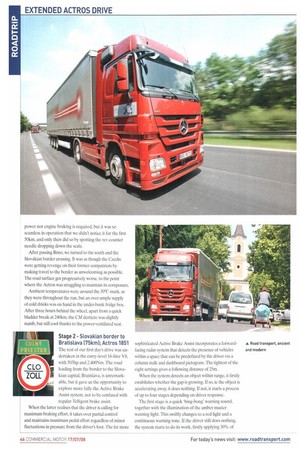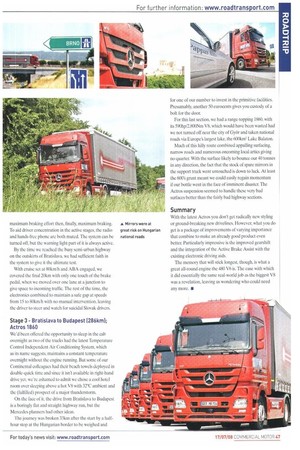European tour
Page 45

Page 46

Page 47

If you've noticed an error in this article please click here to report it so we can fix it.
The intrepid Colin Barnett goes East for an extended drive of Mercedes' latest Actros range in real-world conditions.
Words: Cohn Barnett / images: Cohn Barnett & Mercedes-Benz Rather than the centrally based driving event that normally accompanies the launch of a new truck, Mercedes-Benz arranged a rather more linear outing for its latest Actros. The drive comprised a convoy travelling in 11 stages from Tallin in Estonia to Sofia in Bulgaria, passing through eight of the newest EU countries.
CM picked up the convoy in the Czech Republic's capital Prague, driving south-west to limo, before heading south into Slovakia and an overnight at Bratislava.
On the second day, the convoy crossed into Hungary and followed a challenging route on mostly national roads to Budapest. Using a mixture of real-life transport arteries gave us an unusual opportunity to try the Actros out in relatively typical conditions.
As new models go, the latest Actros definitely falls in the evolutionary category; even the keenest truckspotter would have to concentrate hard to spot the difference.
But beneath the skin there are 37 improvements, and our international drive provided the perfect chance to judge their success. However we failed to see any benefit in item 23 — a large, swivelling shaving mirror...
Stage 1 — Prague to Slovakian border 1258krn1; Actros 1848 All eight trucks in the convoy were fitted with MegaSpace cabs, but with a variety of nominal engine ratings from 440 to 600hp. We drove the first part of the route in an 1848, powered by the top-rated 12-litre V6 engine delivering 469hp and 2,300Nm. Like every on-road Actros, it came with the latest version of the PowerShift 2 12-speed automated manual transmission as standard. All the trucks were fitted with Voith retarders, Telligent stability control, brake assist and lane assist, and Active Brake Assist (ABA). Having negotiated the not inconsiderable climb into the high cab, the surroundings looked familiar. Leaving the starting point in the direction of Prague gave us a chance to experience the low-speed handling as we instantly had to negotiate a rather complex junction to turn 180°. The claims of improved shift speed and smoothness seemed justified as gearchanges were barely noticeable.
The first 200km to Brno were marked by two, occasionally three, lanes of highway with a smattering of medium-strength hills, each with a handy slow-vehicle lane. With cruise control set at 90km/h, progress up the hills seemed acceptable enough. It was only after we had held back to let one of the 600s go past, then discovered it was still in sight 60km later, that we realised just what an effective unit the most powerful V6 really is.
We got into the habit of pressing the Power button on the dash at the start of each crawler lane, moving the gearshift points up the rev counter a couple of segments. It didn't lose much ground to the 600 up the hills — down them, and on the flat, there was nothing to lose anyway.
PowerShift 2 comes with an EcoRoll function, which engages neutral when neither power nor engine braking is required, but it was so seamless in operation that we didn't notice it for the first 50km, and only then did so by spotting the rev counter needle dropping down the scale.
After passing Brno, we turned to the south and the Slovakian border crossing. It was as though the Czechs were getting revenge on their former compatriots by making travel to the border as unwelcoming as possible. The road surface got progressively worse, to the point where the Actros was struggling to maintain its composure, Ambient temperatures were around the 30°C mark, as they were throughout the run, but an over-ample supply of cold drinks was on hand in the under-hunk fridge box. After three hours behind the wheel, apart from a quick bladder break at 240km, the CM derriere was slightly numb, but still cool thanks to the power-ventilated seat.
Stage 2Slovakian border to Bratislava 175km); Actros 1851
The rest of our first day's drive was undertaken in the entry-level 16-litre V8, with 503hp and 2,400Nm. The road leading from the border to the Slovakian capital, Bratislava, is unremarkable, but it gave us the opportunity to explore more fully the Active Brake Assist system, not to be confused with regular Telligent brake assist.
When the latter realises that the driver is calling for maximum braking effort, it takes over partial control and maintains maximum pedal effort regardless of minor fluctuations in pressure from the driver's foot. The far more sophisticated Active Brake Assist incorporates a forwardfacing radar system that detects the presence of vehicles within a space that can be predefined by the driver via a column stalk and dashboard pictogram. The tightest of the eight settings gives a following distance of 25m.
When the system detects an object within range, it firstly establishes whether the gap is growing. If so, ie the object is accelerating away, it does nothing. If not, it starts a process of up to four stages depending on driver response.
The first stage is a quick bing-bong' warning sound, together with the illumination of the amber master warning light. This swiftly changes to a red light and a continuous warning tone. If the driver still does nothing, the system starts to do its work, firstly applying 30% of maximum braking effort then, finally, maximum braking. To aid driver concentration in the active stages, the radio and hands-free phone are both muted. The system can be turned off, but the warning light part of it is always active.
By the time we reached the busy semi-urban highway on the outskirts of Bratislava, we had sufficient faith in the system to give it the ultimate test
With cruise set at 80km/h and ABA engaged, we covered the final 20km with only one touch of the brake pedal, when we moved over one lane at a junction to give space to incoming traffic. The rest of the time, the electronics combined to maintain a safe gap at speeds from 15 to 80kmth with no manual intervention, leaving the driver to steer and watch for suicidal Slovak drivers.
Stage 3 Bratislava to Budapest 1286km); Actros 1860 We'd been offered the opportunity to sleep in the cab overnight as two of the trucks had the latest Temperature Control Independent Air Conditioning System, which as its name suggests, maintains a constant temperature overnight without the engine running. But some of our Continental colleagues had their beach towels deployed in double-quick time and since it isn't available in right-hand drive yet, we're ashamed to admit we chose a cool hotel room over sleeping above a hot V8 with 32T ambient and the (fulfilled) prospect of a major thunderstorm.
On the face of it, the drive from Bratislava to Budapest is a boringly flat and straight highway run, but the Mercedes planners had other ideas.
The journey was broken 33km after the start by a halfhour stop at the Hungarian border to he weighed and for one of our number to invest in the primitive facilities. Presumably, another 50 eurocents gives you custody of a bolt for the door.
For this last section, we had a range-topping 1860. with its 590hp/2,800Nm V8, which would have been wasted had we not turned off near the city of GyOr and taken national roads via Europe's largest lake, the 600km2 Lake Balaton.
Much of this hilly route combined appalling surfacing, narrow roads and numerous oncoming local artics giving no quarter. With the surface likely to bounce our 40 tonnes in any direction, the fact that the stock of spare mirrors in the support truck went untouched is down to luck. At least the 600's grunt meant we could easily regain momentum if our bottle went in the face of imminent disaster. The Actros suspension seemed to handle these very bad surfaces better than the fairly had highway sections.
Summary
With the latest Actros you don't get radically new styling or ground-breaking new drivelines. However, what you do get is a package of improvements of varying importance that combine to make an already good product even better. Particularly impressive is the improved gearshift and the integration of the Active Brake Assist with the existing electronic driving aids.
The memory that will stick longest, though, is what a great all-round engine the 480 V6 is. The ease with which it did essentially the same real-world job as the biggest V8 was a revelation, leaving us wondering who could need any more. IN












































































































































































